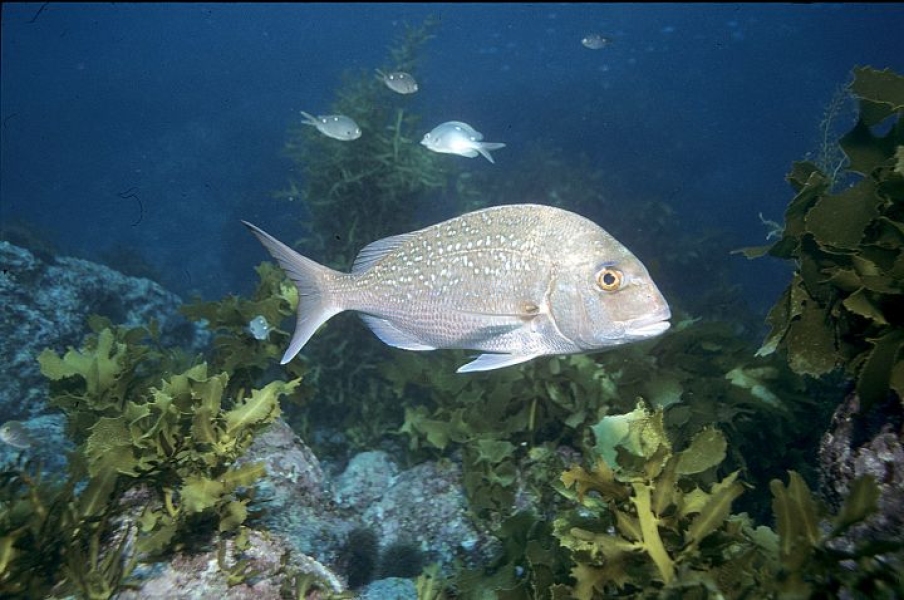Snapper are New Zealand’s most prized fish; they are the fish fishermen love-to-love. They live in a wide range of habitats in New Zealand’s warmer coastal waters, around the North Island and the top of the South, and prefer depths of 5–60 metres. They grow to a decent size: up to 105 cm in length.
Snapper are New Zealand’s most prized fish; they are the fish fishermen love-to-love. They live in a wide range of habitats in New Zealand’s warmer coastal waters, around the North Island and the top of the South, and prefer depths of 5–60 metres. They grow to a decent size: up to 105 cm in length.
Snapper is a very apt name. “They’ve got big grunty molars – that’s why they are called snapper. Don’t accidentally put your fingers inside a big snapper’s mouth, as it literally will crush them,” says Dr Mark Morrison, who is a Fisheries Ecologist at the National Institute of Water & Atmospheric Research (NIWA).
Sporting electric blue dots, with a contrasting light copper-pink colour and a silver-white underside, they are delicious to look at and to taste; with a sweet mild flavour.
Over the course of a year, from 700 000–1 400 000 snapper are caught by recreational fishers in the inner Hauraki Gulf (depending on weather and fish movements). That’s 400–800 tonnes, a quarter of the recreational take of all New Zealand snapper. Most of these are caught during the summer months.
Snapper can live to a ripe old age – up to 60 years. These big old fish are often affectionately known as ‘old man snapper’. Most snapper caught by recreational anglers in New Zealand are younger; usually between 30 and 50 years.
Big snapper have a different diet to smaller snapper. What they eat changes considerably with the size of the fish. The juveniles eat crustaceans which they find just above the sand. As they grow in size, snapper eat a wider range of invertebrates, including crabs, worms, and shellfish. Large snapper have powerful teeth, and can easily cope with hard-shelled animals such as paua, mussels, limpets, and sea urchins.
Snapper are normally characterised as being ‘shy’ and will dart away from you in the water, if approached.
“Fish don’t have eyelids and when we have been counting and measuring them at night on the seafloor, where they sleep, their eyes are open,” says Dr Morrison. In fact, if you are stealthy, you can actually capture sleeping snapper using a diver catch bag.
Surprisingly, all snapper begin life as females. During their third and fourth years of life, about half of them change sex, going through a hermaphroditic stage, to become males. By the time they mature, at about 23 – 26 cm and 3 – 5 years old, the population consists of about half males and half females.
Snapper are social fish. Dr Morrison says for some tagged snapper returns, several fish tagged at the same time and place have been re-caught together months or years later, many kilometres away from where they were released. This suggests that the same individual fish school together and move around over many years. How they keep tabs on each other, no one knows.
Research suggests that snapper growth rates are affected primarily by factors such as stock size, temperature, food availability, and genetic diversity, and may be highly variable both within and between stocks.
Scientist bio:
Dr Mark Morrison joined NIWA in 1996. He has been involved in lots of projects that are “Snapperocentric”, like finding out that most west coast snapper originate as juveniles from the Kaipara Harbour, quantifying adult snapper movement in the inner Hauraki Gulf through the tagging of about
10 000 snapper, and confirming both resident and migratory behavioural groups.
Dr Morrison and his team are currently working on a project using chemical markers in snapper ear-bones, and morphology (body shape and other measures) to see if a marker for movement can be developed. Tagged snapper returned by recreational and commercial fishers are being used for this work, as it is known where and when they were tagged, and subsequently recaptured. If a marker can be found, then this will help us better understand how fish migrations and movements work in New Zealand snapper populations.
|
Species Fact File |
|
|
Common names: |
Snapper |
|
Māori name: |
Tamure |
|
Scientific name: |
Pagrus auratus |
|
Type: |
Bony fish |
|
Family: |
Sparidae |
|
Size: |
Average size is 30–50 cm. They grow up to 105 cm but most don’t make it that far. |
|
Lifespan: |
Up to 60 years |
|
Diet: |
Very varied diet of shellfish and fish |
|
Reproduction: |
Spawning occurs when several males and a female make upwards rushes of several metres before releasing clouds of eggs and sperm into the sea. Each female spawns many thousands of eggs, which the males fertilise by releasing sperm into the water at the same time. Spawning takes place in the late afternoon or evening. Fertilised eggs develop into larvae which drift in plankton for 18–32 days. Juveniles then begin settling down to the bottom at a length of 2–3 cm during summer. Snapper, stay close to where they were born until they reach maturity at 3–4 years old (20–28 cm) and then swim away from their nursery ground. |
|
Things you need to know: |
The maximum daily limit is nine snapper per person. Stocks are now managed by strict quotas for commercial fishing under the Quota Management System (QMS). Put back fish under 27 cm. |
|
Something strange: |
They sleep with their eyes open on the sea floor. They are all born female. About half of them switch from female to male before maturity at 3–5 years old. |

